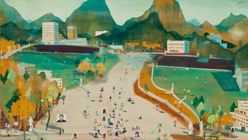Welcome to Help Desk, where I answer your queries about making, exhibiting, finding, marketing, buying, selling — or any other activity related to — contemporary art. Email helpdesk@dailyserving.com with questions. All submissions remain strictly confidential and become the property of Daily Serving. Help Desk spreads the love on Twitter: @ArtHelpDesk
I am a painter with good gallery representation. There seems to be public interest in the work I make and I am sometimes asked about prints or reproductions. As a printmaker, I don’t like the idea of “limited edition” art prints that blur the line between hand-pulled work and technically limitless reproductions, but I’ve always been a fan of the accessibility of posters and the 9″ x 12″ reproductions you can buy in museum gift shops. I’m not so successful I can afford to print off and give away a big run of such things. Is there a middle ground in publishing reproductions? Something where non-collector fans could spend $10 – $50 on a picture? I’d rather like to send a nice .tif to anyone who asks and suggest they print it out on their own computer. For $5 I could mail them a sticker with my actual signature.
This is the Art Police! Put the mouse down and step away from the computer!
While I appreciate the spirit of your generosity, I beg you to abandon the idea of sending .tif files of your work to your admirers. For one thing, you can’t control what the recipient of such a file would do with it once it’s in her possession. She might blow it up or crop it, change the colors, or run it through some ghastly Photoshop filter. There’s also the issue of the subsequent printing, since a home-use HP or Epson isn’t calibrated for color or quality in the same way that a printing house has control of their giclee printers. In the end, who knows what might happen to your image: it could end up re-sized, re-colored, and smudgy — and then it would bear a sticker with your name on the bottom. I won’t arrest you this time, but consider this an Official Warning.




